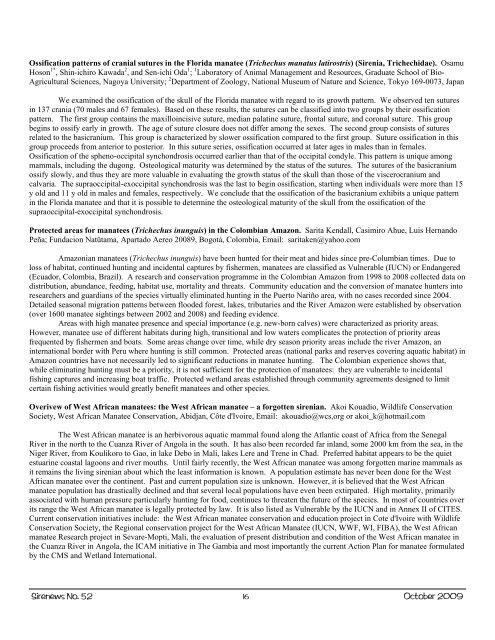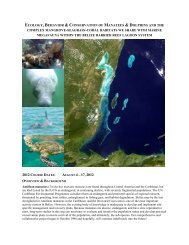Tribute to Dr. Akoi Kouadio - Sirenian International
Tribute to Dr. Akoi Kouadio - Sirenian International
Tribute to Dr. Akoi Kouadio - Sirenian International
You also want an ePaper? Increase the reach of your titles
YUMPU automatically turns print PDFs into web optimized ePapers that Google loves.
Ossification patterns of cranial sutures in the Florida manatee (Trichechus manatus latirostris) (Sirenia, Trichechidae). Osamu<br />
Hoson 1* , Shin-ichiro Kawada 2 , and Sen-ichi Oda 1 ; 1 Labora<strong>to</strong>ry of Animal Management and Resources, Graduate School of Bio-<br />
Agricultural Sciences, Nagoya University; 2 Department of Zoology, National Museum of Nature and Science, Tokyo 169-0073, Japan<br />
We examined the ossification of the skull of the Florida manatee with regard <strong>to</strong> its growth pattern. We observed ten sutures<br />
in 137 crania (70 males and 67 females). Based on these results, the sutures can be classified in<strong>to</strong> two groups by their ossification<br />
pattern. The first group contains the maxilloincisive suture, median palatine suture, frontal suture, and coronal suture. This group<br />
begins <strong>to</strong> ossify early in growth. The age of suture closure does not differ among the sexes. The second group consists of sutures<br />
related <strong>to</strong> the basicranium. This group is characterized by slower ossification compared <strong>to</strong> the first group. Suture ossification in this<br />
group proceeds from anterior <strong>to</strong> posterior. In this suture series, ossification occurred at later ages in males than in females.<br />
Ossification of the spheno-occipital synchondrosis occurred earlier than that of the occipital condyle. This pattern is unique among<br />
mammals, including the dugong. Osteological maturity was determined by the status of the sutures. The sutures of the basicranium<br />
ossify slowly, and thus they are more valuable in evaluating the growth status of the skull than those of the viscerocranium and<br />
calvaria. The supraoccipital-exoccipital synchondrosis was the last <strong>to</strong> begin ossification, starting when individuals were more than 15<br />
y old and 11 y old in males and females, respectively. We conclude that the ossification of the basicranium exhibits a unique pattern<br />
in the Florida manatee and that it is possible <strong>to</strong> determine the osteological maturity of the skull from the ossification of the<br />
supraoccipital-exoccipital synchondrosis.<br />
Protected areas for manatees (Trichechus inunguis) in the Colombian Amazon. Sarita Kendall, Casimiro Ahue, Luis Hernando<br />
Peña; Fundacion Natütama, Apartado Aereo 20089, Bogotá, Colombia, Email: saritaken@yahoo.com<br />
Amazonian manatees (Trichechus inunguis) have been hunted for their meat and hides since pre-Columbian times. Due <strong>to</strong><br />
loss of habitat, continued hunting and incidental captures by fishermen, manatees are classified as Vulnerable (IUCN) or Endangered<br />
(Ecuador, Colombia, Brazil). A research and conservation programme in the Colombian Amazon from 1998 <strong>to</strong> 2008 collected data on<br />
distribution, abundance, feeding, habitat use, mortality and threats. Community education and the conversion of manatee hunters in<strong>to</strong><br />
researchers and guardians of the species virtually eliminated hunting in the Puer<strong>to</strong> Nariño area, with no cases recorded since 2004.<br />
Detailed seasonal migration patterns between flooded forest, lakes, tributaries and the River Amazon were established by observation<br />
(over 1600 manatee sightings between 2002 and 2008) and feeding evidence.<br />
Areas with high manatee presence and special importance (e.g. new-born calves) were characterized as priority areas.<br />
However, manatee use of different habitats during high, transitional and low waters complicates the protection of priority areas<br />
frequented by fishermen and boats. Some areas change over time, while dry season priority areas include the river Amazon, an<br />
international border with Peru where hunting is still common. Protected areas (national parks and reserves covering aquatic habitat) in<br />
Amazon countries have not necessarily led <strong>to</strong> significant reductions in manatee hunting. The Colombian experience shows that,<br />
while eliminating hunting must be a priority, it is not sufficient for the protection of manatees: they are vulnerable <strong>to</strong> incidental<br />
fishing captures and increasing boat traffic. Protected wetland areas established through community agreements designed <strong>to</strong> limit<br />
certain fishing activities would greatly benefit manatees and other species.<br />
Overivew of West African manatees: the West African manatee – a forgotten sirenian. <strong>Akoi</strong> <strong>Kouadio</strong>, Wildlife Conservation<br />
Society, West African Manatee Conservation, Abidjan, Côte d'Ivoire, Email: akouadio@wcs,org or akoi_k@hotmail.com<br />
The West African manatee is an herbivorous aquatic mammal found along the Atlantic coast of Africa from the Senegal<br />
River in the north <strong>to</strong> the Cuanza River of Angola in the south. It has also been recorded far inland, some 2000 km from the sea, in the<br />
Niger River, from Koulikoro <strong>to</strong> Gao, in lake Debo in Mali, lakes Lere and Trene in Chad. Preferred habitat appears <strong>to</strong> be the quiet<br />
estuarine coastal lagoons and river mouths. Until fairly recently, the West African manatee was among forgotten marine mammals as<br />
it remains the living sirenian about which the least information is known. A population estimate has never been done for the West<br />
African manatee over the continent. Past and current population size is unknown. However, it is believed that the West African<br />
manatee population has drastically declined and that several local populations have even been extirpated. High mortality, primarily<br />
associated with human pressure particularly hunting for food, continues <strong>to</strong> threaten the future of the species. In most of countries over<br />
its range the West African manatee is legally protected by law. It is also listed as Vulnerable by the IUCN and in Annex II of CITES.<br />
Current conservation initiatives include: the West African manatee conservation and education project in Cote d'Ivoire with Wildlife<br />
Conservation Society, the Regional conservation project for the West African Manatee (IUCN, WWF, WI, FIBA), the West African<br />
manatee Research project in Sevare-Mopti, Mali, the evaluation of present distribution and condition of the West African manatee in<br />
the Cuanza River in Angola, the ICAM initiative in The Gambia and most importantly the current Action Plan for manatee formulated<br />
by the CMS and Wetland <strong>International</strong>.<br />
Sirenews No. 52 16 Oc<strong>to</strong>ber 2009













